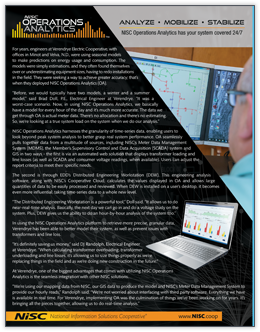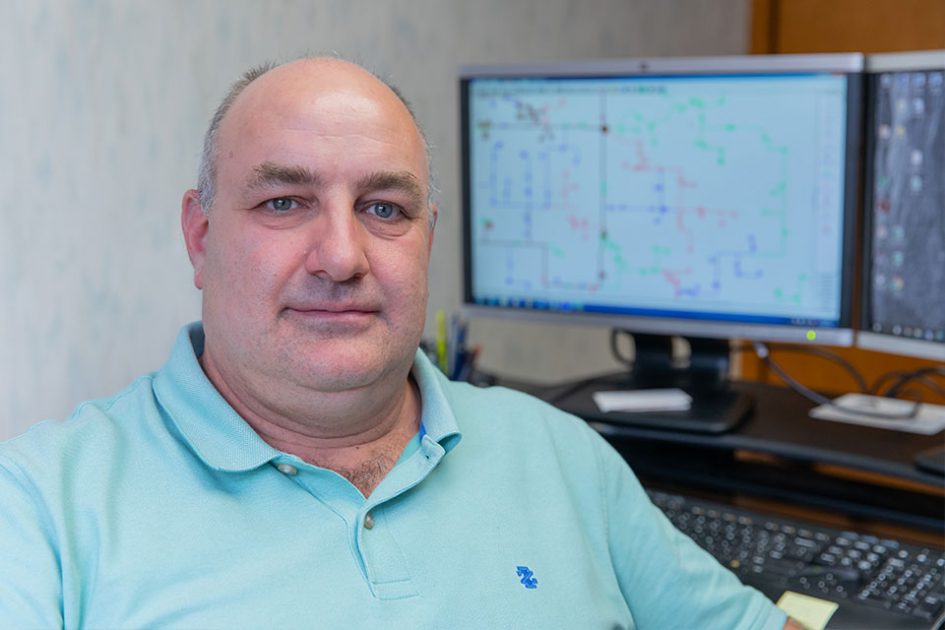 For years, engineers at Verendrye Electric Cooperative, with offices in Minot and Velva, N.D., were using seasonal models to make predictions on energy usage and consumption. The models were simply estimations, and they often found themselves over or underestimating equipment sizes, having to redo installations in the field. They were seeking a way to achieve greater accuracy; that’s when they deployed NISC Operations Analytics (OA).
For years, engineers at Verendrye Electric Cooperative, with offices in Minot and Velva, N.D., were using seasonal models to make predictions on energy usage and consumption. The models were simply estimations, and they often found themselves over or underestimating equipment sizes, having to redo installations in the field. They were seeking a way to achieve greater accuracy; that’s when they deployed NISC Operations Analytics (OA).
“Before, we would typically have two models, a winter and a summer model,” said Brad Doll, P.E., Electrical Engineer at Verendrye. “It was a worst-case scenario. Now, in using NISC Operations Analytics, we basically have a model for every hour of the day and it’s much more accurate. The data we get through OA is actual meter data. There’s no allocation and there’s no estimating. So, we’re looking at a true system load on the system when we do our analysis.”
NISC Operations Analytics harnesses the granularity of time-series data, enabling users to look beyond peak system analysis to better grasp real system performance. OA seamlessly pulls together data from a multitude of sources, including NISC’s Meter Data Management System (MDMS), the Member’s Supervisory Control and Data Acquisition (SCADA) system and GIS in two ways – the first is via an automated web solution that displays transformer loading and line losses (as well as SCADA and consumer voltage readings, when available). Users can adjust the report criteria to meet their specific needs.
The second is through EDD’s Distributed Engineering Workstation (DEW). This engineering analysis software, along with NISC’s Cooperative Cloud, calculates the values displayed in OA and allows large quantities of data to be easily processed and reviewed. When DEW is installed on a user’s desktop, it becomes even more influential, taking time-series data to a whole new level.
“The Distributed Engineering Workstation is a powerful tool,” Doll said. “It allows us to do near-real-time analysis. Basically, the next day we can go in and do a voltage study on the system. Plus, DEW gives us the ability to do an hour-by-hour analysis of the system too.”
In using the NISC Operations Analytics platform to retrieve more precise, granular data, Verendrye has been able to better model their system, as well as prevent issues with transformers and line loss.
“It’s definitely saving us money,” said DJ Randolph, Electrical Engineer
at Verendrye. “When calculating transformer overloading, transformer underloading and line losses, it’s allowing us to size things properly as we’re replacing things in the field and as we’re doing new construction in the future.”
At Verendrye, one of the biggest advantages that comes with utilizing NISC Operations Analytics is the seamless integration with other NISC solutions.
“We’re using our mapping data from NISC, our GIS data to produce the model and NISC’s Meter Data Management System to provide our hourly reads,” Randolph said. “We’re not worried about interfacing with third party software. Everything we have is available in real time. For Verendrye, implementing OA was the culmination of things we’ve been working on for years. It’s bringing all the pieces together, allowing us to do real-time analysis.”

